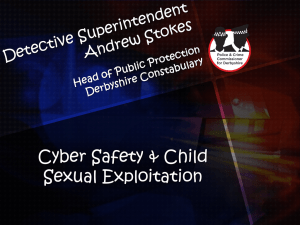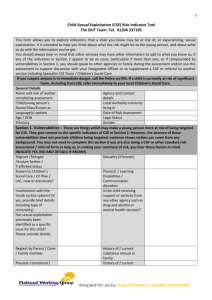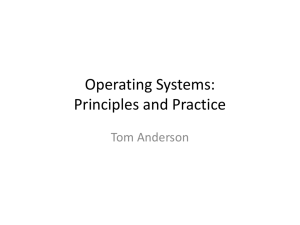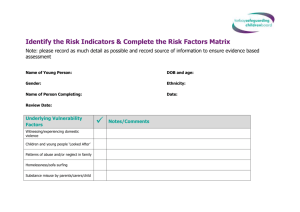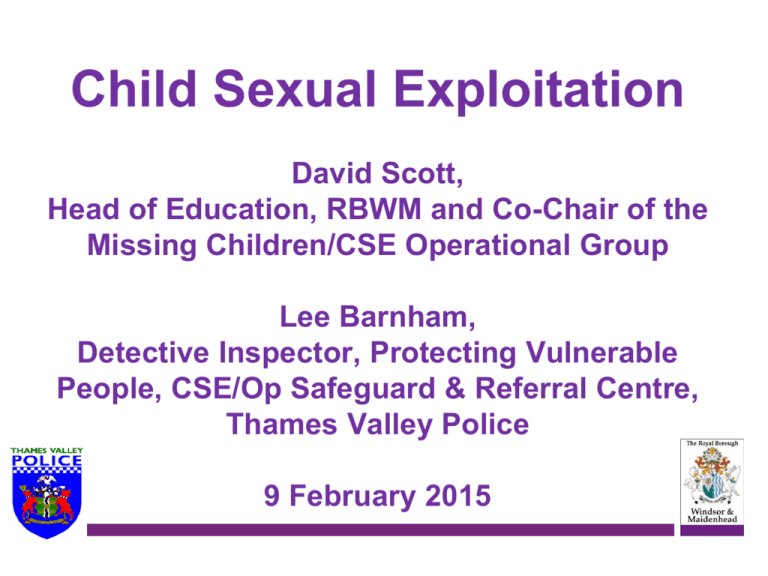
Child Sexual Exploitation
David Scott,
Head of Education, RBWM and Co-Chair of the
Missing Children/CSE Operational Group
Lee Barnham,
Detective Inspector, Protecting Vulnerable
People, CSE/Op Safeguard & Referral Centre,
Thames Valley Police
9 February 2015
Scope of this presentation
•
•
•
•
•
•
•
•
•
•
Defining child sexual exploitation
Grooming & smart phones
Missing children and CSE in RBWM
The Thames Valley Police three tier response
Schools responsibilities
What to look out for
What to do if you suspect CSE
What happens once a referral is made
Local data
Resources
Definition of Child Sexual Exploitation (CSE) from
the Association of Chief Police Officers (ACPO)
Sexual exploitation of children and young people under
18 involves exploitative situations, contexts and
relationships where young people (or a third person or
persons) receive ‘something’ (e.g. food, accommodation,
drugs, alcohol, cigarettes, affection, gifts, money) as a
result of them performing, and/or another or others
performing on them, sexual activities.
Note:
Organised exploitation varies from spontaneous networking between groups
of perpetrators to more serious organised crime where young people are
effectively ‘sold’. These activities are described as ‘internal trafficking’ or
‘trafficking for child sexual exploitation’.
Grooming
Grooming using the Internet and mobile technology is
becoming increasingly common.
Child Exploitation and Online Protection (CEOP) found
that almost a third of children in their study admitted to
having met someone whom they had previously only
met online (CEOP 2009).
In 2012 there were 1,145 reports relating to incidents of
online grooming. 7% of these related to attempts to
meet a child offline (CEOP 2013).
Impact of Smart Phones
• 6 out of 10 (62%) 12-15 year olds now have a smart phone.
• Smart phone ownership has increased by 21% among 12-15
year olds.
• The built in cameras and online access with a new generation
of Apps makes communication with strangers online and
sharing images much easier.
• CEOP knows that instant messaging is a popular method of
communication and is used by groomers to approach potential
victims.
• Instant messaging (e.g. Snapchat, Instagram, BBM, Skype,
MSN Messenger) was used by offenders to make contact with
children in approx ⅓ of reports of grooming in 2012/13.
• BUT over ⅔ (69%) of parents of 12-15 year olds with a phone
that can be used online do not have mobile phone parental
controls in place – compared to 49% of parents who have
controls in place for their child’s laptop or tablet.
Missing Children and CSE in RBWM
Missing
Children
•
•
•
CSE
and
Missing Children
CSE
The argument for bringing the missing children/CSE agendas together
The dynamic between operational and strategic issues
Local arrangements in RBWM
Missing and Absent Children
• TVP introduced a revised protocol in April 2014.
• Missing is a key indicator but must not be relied on
alone.
• Not all CSE victims are reported missing.
• Not all missing children are at risk of CSE.
Joint Protocol for Missing Children
• Joint protocol for Thames Valley Police and Children’s
Services Authorities
http://berks.proceduresonline.com/pdfs/joint_pr_ch.pdf
• LSCB’s Missing Children/Young People & Child Sexual
Exploitation Strategy 2015/16
http://www.wamlscb.org/professionals/child-sexual-exploitation/
• Roles and responsibilities of schools
• Information sharing – schools’ opportunities to notice
small changes
Missing / Absent Changes April 2014
•
•
•
Missing – ‘Anyone whose whereabouts cannot be established and
where the circumstances are out of character or the context suggests
the person may be the subject of crime or at risk of harm to
themselves or another’
Absent – ‘A person not at a place where they are expected or required
to be’
Thames Valley Police Absent policy – The following will never be
recorded as absent due to the risk and will always be missing:
–
–
–
•
All children under 14
All persons under 18 who have a CSE flag, CSE intelligence or named in a Child
Abduction warning notice
All known sex offenders
Schools should have robust procedures in place to ensure information
on missing children is discussed with their Designated Person for
Safeguarding and the DPS feels confident to disseminate information
both within the school and with children’s social care in order to
ensure all episodes of “missing” are recorded and reported to the
Police through 101.
Missing Children and CSE structure in RBWM
The Windsor and Maidenhead Missing Children/CSE
Strategic Group is a sub group of the Local Safeguarding
Children Board and reports back regularly to the LSCB. It is cochaired by:
– RBWM Director of Children’s Services – Alison Alexander and
– Thames Valley Police Local Commander – Kate Ford
The Missing Children/CSE Operational Group meets monthly
to consider individual cases of children and young people at risk
of CSE and is co-chaired by:
– Head of Education, Strategy and Commissioning – David Scott and
– TVP Acting Chief Inspector: Windsor and Maidenhead LPA – Emily
Roberts
Schools can make referrals into the Operational Group by
reporting on individual cases through children’s social care. The
Co-Chairs can also provide informal advice.
Thames Valley Police 3 Tiers
RBWM, Thames Valley Police and partners categorise concerns
around child sexual exploitation under three levels.
Level 1: Children/young people where there is no current
information that they are at risk of CSE but who have previously
been linked to CSE and/or are displaying the warning signs.
Level 2: Children and young people where there is information
that suggests a current risk of CSE but no disclosures or evidence
of CSE.
Level 3: Children/young people where there has been a
disclosure of sexual offences perpetrated against them or where
an active investigation is taking place due to corroborated
intelligence or evidence regarding CSE.
Sexual Exploitation Risk Assessment (SERA) Model
Description of young person with risk indicators in level 1
Smaller number of risk factors identified or movement from levels 2 or 3. For example: sexualised risk
taking behaviours, beginning to truant from school, occasionally going missing, going to known places
of concern, early signs of problem drugs or alcohol use.
Description of young person with risk factors identified
in level 3
Multiple risk factors. For example: entrenched in one or
more abusive relationships, contact with known
perpetrators, going missing and running away from home
regularly, problem alcohol and/or drug use, experience of
violence, intimidation and fear.
Description of young person with risk factors in
level 2
Fewer risk factors or signals (or reduction from level 3).
For example: regularly going missing, swapping sex for
goods, monies. Truanting regularly from school. Going
to places of concern 'HOT SPOTS', involved with
vulnerable peers, experiencing violence, intimidation
and fear. Developing drug and alcohol use.
Key Principles Involved (1)
• Sexual exploitation includes sexual, physical and emotional
abuse, as well as, in some cases, neglect.
• Children do not make informed choices to enter or remain in
sexual exploitation, but do so from coercion, enticement,
manipulation or desperation.
• Children under 16 years of age cannot consent to sexual activity.
• There is no defence in law to sexual activity with a child under the
age of 13. All that needs to be proved is that sexual activity has
taken place.
• Sexually exploited children should be treated as victims of abuse,
not as offenders.
• Children under 16 years of age will always be dealt with as actual
or potential victims.
• Between the ages of 16 and 18, consideration may be given, in
very limited circumstances and where all other options have failed,
to the use of criminal justice action.
Key Principles Involved (2)
• Many sexually exploited children have difficulty distinguishing
between their own choices around sex and sexuality and the
sexual activities they are coerced into.
• The primary law enforcement effort must be against the coercers
and sex abusers, who may be adult, but could also be the child’s
peers or young people who are older than the child.
• Sexually exploited children are children in need of services under
the Children Act 1989 and 2004. They are also children in need of
protection.
• A multi-agency network or planning meeting/discussion should
take place for all children considered at risk of sexual exploitation.
Schools’ Responsibilities
• Missing Children & Child Sexual Exploitation are part of the
Safeguarding responsibilities within schools – see statutory
guidance “Keeping children safe in education” DfE, April 2014
& Working Together 2013 Guidance
https://www.gov.uk/government/publications/keeping-children-safe-in-education
https://www.gov.uk/government/publications/working-together-to-safeguardchildren
• The Designated Person for Safeguarding (may also be known
as Designated Person for Child Protection) needs to ensure all
staff in the school are aware of CSE and the potential
indicators.
• The Governing Body should be creating a culture where staff
are able to challenge over safeguarding concerns through the
whistle blowing policy and the “managing allegations against
staff” procedure.
What to look out for (1)
Signs and indicators of being sexually exploited:
•
•
•
•
•
•
•
•
•
•
•
•
Absence from school.
Change in physical appearance.
Physical injuries.
Receipt of gifts from unknown sources.
Two mobile phones.
Evidence of sexual bullying and/or vulnerability through
the internet and/or social networking sites.
Drug or alcohol misuse. Involvement in offending.
Missing from home or care.
Estranged from their family.
Recruiting others into exploitative situations.
Poor self esteem or self confidence and/or mental health
concerns e.g. self-harm or thoughts of or attempts at
suicide.
Repeat sexually-transmitted infections, pregnancy and
terminations.
What to look out for (2)
•Typical vulnerabilities:
• Living in a chaotic or dysfunctional household (including parental
substance use, domestic violence, parental mental health issues,
parental criminality).
• History of abuse (including familial child sexual abuse, risk of
forced marriage, risk of ‘honour’- based violence, physical and
emotional abuse and neglect).
• Recent bereavement or loss or young carer responsibilities.
• Gang association either through relatives, peers or intimate
relationships.
• Lacking friends from the same age group.
• Friends with young people who are sexually exploited.
• Learning disabilities.
• Unsure about their sexual orientation or unable to disclose sexual
orientation to their families.
• Living in residential care, a hostel, bed and breakfast
accommodation or other temporary accommodation e.g. sofa
surfing.
What to do if you suspect CSE
Talk to your Designated Safeguarding Lead immediately
The school’s Designated Person for Safeguarding can
make a referral
• Children’s Social Care, Referral & Assessment: 01628
683150, or
• Out of hours Emergency Duty Team : 01344 786543
Ask for additional advice
• Missing Children/CSE Group Co-Chairs - David Scott
07710 352095 or Emily Roberts 0780 0702291
CSE Indicator Tool and what happens
Berkshire LSCB Child Protection Procedures
CSE Indicator Tool
http://berks.proceduresonline.com/chapters/p_ch_sex_exploit.html
• Key details including any disclosure of CSE / abuse
• Domains – what is known / not known
–
–
–
–
–
Health
Behaviours
Grooming
Family and Social
Safety
Missing Children/CSE Operational Group
– Multi agency / monthly meeting / Tracking / Interventions
including disruptive actions
CSE Prevalence
Nationally the prevalence of CSE is difficult to
ascertain with any accuracy due to:
• Low levels of reporting by children/young people.
• Variable levels of awareness and understanding of
definitions.
• Inadequate intelligence gathering and information
sharing.
• Inconsistent recording.
Locally in RBWM we have just over one year’s worth of
details.
RBWM Local CSE data at levels 1, 2 and 3
December 2013 –
January 2015
Age profile
January 2015 Current open cases
Level 1
Level 2
Level 3
Total
16
12
10
38
1 x 13 yrs old
4 x 14 yrs old
6 x 15 yrs old
2 x 16 yrs old
2 x 17 yrs old
1 x 18 yrs old
4
4 x 13 yrs old
4 x 14 yrs old
4 x 17 yrs old
6
3 x 14 yrs old 5 x 13 yrs old
2 x 15 yrs old 11 x 14 yrs old
3 x 16 yrs old 8 x 15 yrs old
2 x 17 yrs old 5 x 16 yrs old
8 x 17 yrs old
1 x 18 yrs old
3
13
Additional Resources
www.thamesvalley.police.uk/crprev-cse
www.thinkuknow.co.uk
www.wamlscb.org
http://www.wamlscb.org/professionals/training/
“Working Together to Safeguard Children” HM Government, March 2013
https://www.gov.uk/government/publications/working-together-to-safeguard-children
“Safeguarding Children & Young People from Sexual Exploitation – Supplementary Guidance to Working
Together to Safeguard Children” HM Government, August 2009
https://www.gov.uk/government/publications/safeguarding-children-and-young-people-from-sexualexploitation-supplementary-guidance
“Keeping children safe in education” DfE, April 2014
https://www.gov.uk/government/publications/keeping-children-safe-in-education
“What to do if you suspect a child is being sexually exploited” DfE, 2012
https://www.gov.uk/government/publications/what-to-do-if-you-suspect-a-child-is-being-sexually-exploited
“School Inspection Handbook” Ofsted, January 2015. Ref No.120101
https://www.gov.uk/government/publications/school-inspection-handbook
“Inspecting safeguarding in maintained schools and academies” Ofsted, January 2015. Ref No.140143
https://www.gov.uk/government/publications/inspecting-safeguarding-in-maintained-schools-and-academiesbriefing-for-section-5-inspections
Windsor & Maidenhead LSCB Missing Children & CSE Strategy 2015-16
http://www.wamlscb.org/professionals/child-sexual-exploitation/
In Conclusion
• Children and young people go missing and child
sexual exploitation does exist in RBWM.
• Schools play a crucial role in spotting the signs.
• All your staff should be clear on your school’s
arrangements and the wider local arrangements.
• If you have information, share it – it could be the
missing piece in the jigsaw.
Questions?
A question was raised regarding the recently issued
supplementary advice from the DfE on the Childcare
Disqualification requirements which was thought to have now
been withdrawn. It has since been clarified that the advice sent
out to schools still stands and schools should act as soon as
possible to implement these requirements.
Case Scenario (1)
Meet “Annie” who is a 14 year old girl at your school.
She is a moderate achiever with a few issues
regarding attendance, late homework and the
occasional spell of disruptive behaviour. She is
entitled to free school meals.
Her form tutor is noticing excited gossip amongst
Annie and her friends about Annie’s new boyfriend.
Annie is looking noticeably smarter in her appearance
and is beginning to wear make up to school.
Comments?
Annie’s form tutor is now noticing Annie
coming into school with more material
possessions e.g. a new phone, make up and a
handbag. Her relationship with her mother is
deteriorating and there is knowledge of them
arguing at the school gates. Annie’s social
development is noticeably outpacing that of her
peers.
Comments?
Annie’s friends tell her form tutor that Annie is getting into a
car with older men that they don’t recognise.
Comments?
One day Annie’s phone rings during lunchtime. She looks
worried and leaves school. There are more rumours about
her getting into an unknown car and she is absent from the
afternoon school session.
Comments?
The next morning Annie is not present in school. Her mum
turns up with a bag of clean clothes as Annie forgot to take
them with her the day before to a sleepover at Isabel’s.
Isabel tries to cover for Annie but it is clear there was no
sleepover.
Comments?
Case Scenario (2)
Hannah is a 16 year old girl. One Monday morning her
form tutor notices:
• She’s more withdrawn than usual and appears
sleepy.
• She seems estranged from her normal friendship
group.
• Unusually her homework hasn’t been completed.
• Feedback from friends is that she’s stopped
seeing them and has started hanging around with
girls in an older year group.
Comments?
Thank you for listening



